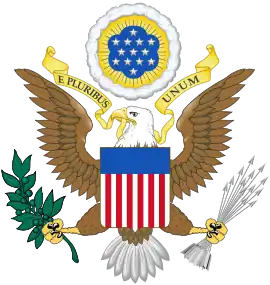Blue Dot Network
The Blue Dot Network (BDN) is a joint project of the United States, Japan, and Australia that supports investment in high-quality infrastructure projects around the world. The BDN works to raise money from investors by certifying projects to strict quality standards.[1][2][3]
 | |
| Formation | November 4, 2019 |
|---|---|
| Founders | |
| Purpose | Provide assessment and certification of infrastructure development projects |
| Location |
|
Region served | Americas, Asia, Europe, Oceania |
| This article is part of a series on the |
| Politics of the United States |
|---|
 |
It was founded in 2019 with $60 billion in initial funding. In 2021, the success of the program influenced the adoption of the Build Back Better World (B3W) initiative by the Group of Seven (G7) nations.
The program was seen as a response to China's One Belt One Road international development project.[4][5]
History
Founding

On 4 November 2019, Overseas Private Investment Corporation acting CEO David Bohigian formally launched the Blue Dot Network at the Indo-Pacific Business Forum (IPBF) in Bangkok, Thailand, revealing the network's details during a panel discussion. The panel included Bohigian, U.S. Under Secretary of State for Economic Growth, Energy, and the Environment Keith Krach, Australia Department of Foreign Affairs and Trade's Richard Maude, and Japan Bank for International Cooperation's Tadashi Maeda.[6]
Bohigian and Australian and Japanese government officials emphasized that the infrastructure built under the project would be high quality. He also highlighted the differences between BDN and China's Belt and Road Initiative, noting that infrastructure development is beneficial “when it is led by the private sector and supported on terms that are transparent, sustainable, and socially and environmentally responsible."[5]
The U.S. International Development Finance Corporation managed to raise $60 billion for the project.[7] In January 2020, the U.S. announced the commitment of $2 million in seed money and invited all G-7 member nations to join.[8]
The project is named after the book Pale Blue Dot by Carl Sagan.[5]
Initiatives
BDN acts as a certification program for international Infrastructure projects, with a focus on Asian projects, particularly gas lines, renewable energy, seaports and airports. Standards are set by the U.S. International Development Finance Corporation,[9] and are meant to assess environmental sustainability, financial transparency, and economic impact.[10] The network relies soley on private sector funding and lacks any lending capacity.[5] The BDN draws from existing standards like the G20 Principles for Quality Infrastructure Investment, the G7 Charlevoix Commitment on Innovative Financing for Development, the Equator Principles, and the OECD Guidelines for Multinational Enterprises. Projects are evaluated on a scale and can be awarded up to three blue dots, similar to the Michelin star rating system.[11]

In June 2021, the G-7 announced the adoption of the Build Back Better World (B3W) initiative built off the progress and principles of the Blue Dot Network to counter China's BRI.[12][13]
In April 2023, the United Kingdom announced that it joined the network's Steering Committee.[11]
See also
References
- Jagannath Panda (31 July 2020). "Shinzo Abe's infrastructure diplomacy". asiatimes.com. Asia Times. Archived from the original on 23 August 2020. Retrieved 19 August 2020.
- "Explained: What is the Blue Dot network, on the table during Trump visit to India". Indian Express. 26 February 2020. Archived from the original on 26 February 2020. Retrieved 28 February 2020.
- Kuo, Mercy A. (7 April 2020). "Blue Dot Network: The Belt and Road Alternative". The Diplomat. Archived from the original on 14 April 2020. Retrieved 9 May 2020.
- Hicks, William. "US counters China with Blue Dot Network". Bangkok Post. Retrieved 29 August 2023.
- Terza, Rob La (11 November 2019). "Connecting the Dots- the U.S.' Answer to the BRI?". U.S.-China Perception Monitor. Retrieved 29 August 2023.
- "The Launch of Multi-Stakeholder Blue Dot Network | DFC". U.S. International Development Finance Corporation. Retrieved 29 August 2023.
- Panda, Dr. Jagannath P. "India, the Blue Dot Network, and the "Quad Plus" Calculus" (PDF). Journal of Indo-Pacific Affairs.
- "US-Led Initiative Aims to Make Mark on Global Infrastructure Development | Voice of America - English".
- Hicks, William. "US counters China with Blue Dot Network". Bangkok Post. Retrieved 29 August 2023.
- "Asian Countries Welcome G7's Answer to China's One Belt, One Road Program". Radio Free Asia. Retrieved 29 August 2023.
- Murphy, Erin L. (20 April 2023). "Blue Dot Network Gains Momentum". Commentary. Center for Strategic and International Studies.
- "Asian Countries Welcome G7's Answer to China's One Belt, One Road Program".
- "FACT SHEET: President Biden and G7 Leaders Launch Build Back Better World (B3W) Partnership". 12 June 2021.